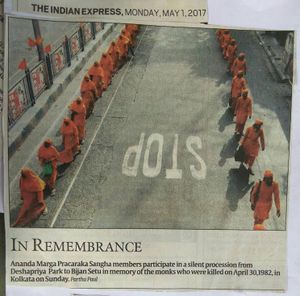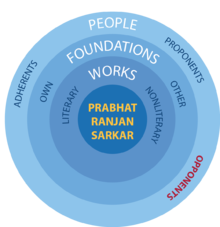Bijon Setu massacre
| Bijon Setu massacre | |
|---|---|
 Procession in memory of those slain in 1982 | |
| Location in Sarkarverse | |
Bijon Setu massacre (Bengali: বিজন সেতু হত্যাকান্ড) refers to the killing and burning of 17 persons, including 1 nun and 14 monks, belonging to Ananda Marga Pracaraka Samgha at Bijon Setu, Kolkata in West Bengal, India on April 30, 1982. Despite the attacks being carried out in broad daylight, no arrests were ever made. After repeated calls for a formal judicial investigation, a single-member judicial commission was set up to investigate the killings in 2012.
Incident
On the morning of April 30, 1982, 17 Ananda Marga members were dragged out of taxis that were taking them to an educational conference at their headquarters in Tiljala in Kolkata's southern suburbs. At three spots simultaneously, they were beaten to death and then set on fire. The killings were witnessed by thousands of people. However, not a single arrest has been made to date.[1]
List of assassinated people
This is the list of the people who were killed on that day—
| Name | Designation |
|---|---|
| Anandapraceta Acarya | Avadhutika |
| Ac. Adishivananda | Avadhuta |
| Ac. Artasevananda | Avadhuta |
| Ac. Balabhadra | Brahmacarii |
| Ac. Bhaveshvarananda | Avadhuta |
| Ac. Giirishananda | Avadhuta |
| Ac. Kamaleshananda | Avadhuta |
| Ac. Krpashivananda | Avadhuta |
| Ac. Mukul | Brahmacarii |
| Ac. Prashivananda | Avadhuta |
| Shrii Ram Raghuvir | Margii from Jaipur |
| Ac. Somnath | Brahmacarii |
| Ac. Subrata | Brahmacarii |
| Ac. Sutreshvarananda | Avadhuta |
| Ac. Venkateshvaranada | Avadhuta |
| Ac. Viirendra | Brahmacarii |
| Unidentified Margii | Body burned beyond recognition |
Initial Press reports and reactions
The Statesman Weekly, the leading Calcutta newspaper at the time, reported a week after the incident that "Seventeen Ananda Margis, two of them women, were done to death on April 30 morning by frenzied mobs at three places in South Calcutta in the suspicion that they were child-lifters."[2] The reporting did not include any compassion for the victims or their families, a tone that prefigured the reaction of both government and the media. Similar unsympathetic reporting appeared in the May 5th edition of the Statesman as well as contemporaneous editions of Sunday and India Today. The Minister of State for Home Affairs was quoted to the effect that the police reaction could have been improved but then went on to reassure members of Parliament that "the Government was watching the activities of the Marg [Ananda Marga members]".[2] In his study on the incident, historian Narasingha Sil concluded the government's overall attitude was that the Ananda Marga members had "got themselves killed because they were so sinfully invidious." [3]:4 The wire story sent out by the UPI added the erroneous detail that two of the nuns who were killed were "seen carrying a child near a railway station".[4]
Explanations
As part of its initial coverage, The Statesman Weekly reported the state's Chief Minister's suspicious that the attack had been staged to embarrass the party in power prior to the upcoming election.[3]:4 Ananda Marga Pracaraka Samgha has always blamed the attack on the Communist Party of India (Marxist). [5]:257 This accusation has been repeated for many years.[6] Allegedly, a mob was stirred up by Communist activists, making unfounded claims of child kidnapping.[7]:20
Investigations and memorials
The National Human Rights Commission took up the investigation of the case in 1996 but did not make much headway, allegedly due to interference from the state government at the time.[8] On April 30, 1999 the Ananda Marga Pracaraka Samgha (AMPS) demanded a high-level judicial probe into the mass killing of Ananda Margiis.[9] On April 30, 2004, Ananda Marga was able to hold the first rally in Calcutta commemorating the massacre without the necessity of first acquiring a court order forcing the police to allow the rally to occur.[10] A single-member judicial commission to investigate the killings was finally empaneled in March 2012.[8]
References
- ^ Namboodiri, Udayan (1997-05-02) "Basu Govt still suppressing facts on Margi massacre" The Indian Express retrieved 2008-07-04
- ^ a b The Statesman Weekly, May 8, 1982, cited in Sil (1988), pp. 3–4, pp. 1, 7
- ^ a b Sil, Narasingha (1988), "The Troubled World of the Ananda Marga: An Examination", The Quarterly Review of Historical Studies 27 (4)
- ^ United Press International (May 1, 1992), Mobs in Calcutta Burn 5 Monks Alive, Stab 12, Sarasota Herald-Tribune
- ^ Crovetto, Helen (2011), "Ananda Marga, Prout, and the Use of Force", in Lewis, James R., Violence and New Religious Movements, Oxford University Press, pp. 249–274, ISBN 9780199735631
- ^ "Controversial Movement Survives Years Of Conflict, Emerges Stronger Than Ever" Hinduism Today May, 1989 retrieved 2013-02-17
- ^ Inayatullah, Sohail (2002) Understanding Sarkar: The Indian Episteme Macrohistory and Transformative Knowledge Brill ISBN 9004121935
- ^ a b Judicial probe into killings of Margis, The Statesman, March 7, 2012
- ^ "Proof into killings of Ananda Margis sought", Indian Express, May 1, 1999[dead link]
- ^ Police nod for Marga rally, The Telegraph, April 28, 2004, retrieved 2013-02-17
